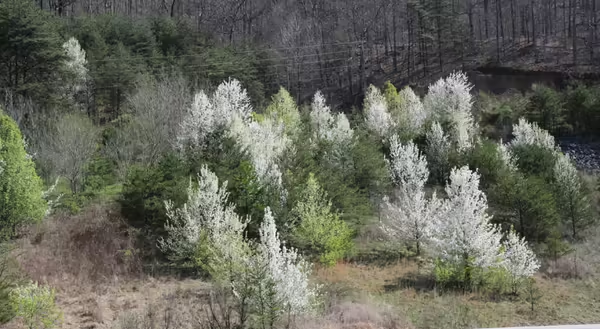
If you’ve been out and about in central Illinois this past week, you’ve probably noticed quite a few things in bloom. Early blooming plants are easy to spot since most of the rest of the landscape is bare now, and most plant lovers are anxiously awaiting the arrival of spring, with anything flowering drawing attention.
In my travels, I always enjoy watching for the progression of blooms that mark the spring awakening. This time of year, I’m seeing more and more tree canopies filled with tiny, white blooms. In fact, these early-blooming trees can be seen across the landscape, from parking lots at retail outlets in designated plantings to wild-growing specimens popping up in ditches, woodland edges, and prairies. The pure white flowers cover pyramidal-shaped canopies of these small to medium-sized trees and are nearly unmistakable due to the timing of their blooms each spring.
A popular ornamental tree
The overwhelming influx of white flower-filled tree canopies this time of year can be attributed to Callery pear (Pyrus calleryana). This medium-sized, non-native tree is widely planted for its ornamental value, with over 20 cultivars available at my last count.
‘Bradford’ is one of the most common cultivars, leading to the more frequently known common name of “Bradford pear.” The plant certainly has ornamental appeal, with nearly a month or more of flower display in the spring, beautiful dark green foliage in summer, excellent fall color, and a nice pyramidal growth habit. So, it's no wonder that it has been extensively planted in the landscape since the 1950s.
The invasive threat
However, this species has begun a conquest of the landscape in true invasive species style over recent decades. While most cultivars are sterile, cross-pollination with many commonly planted fruit trees has created fertile fruits. The result has been an overwhelming influx of these trees in all corners of the natural and built environments.
It prefers open, sunny locations, making any prairie restoration an ideal growing environment for seeds that arrive in bird droppings. This plant isn’t able to exist in shaded, forested settings or areas with regular mowing, but on any of the open-sun fringes of the landscape that remain unmanaged, you can see this plant popping up and eventually taking over.
Its spread is threatening natural areas across the US, with prairies and other full-sun habitats being a major target. Beyond natural areas, many of our travel corridors and other rights-of-way are harboring an incredible seed source as this plant spreads beyond the land manager's ability to control it. This enormous seed source is becoming an overwhelming force, aiding the plant's conquest of valuable natural areas and creating an economic crisis as the cost of controlling this plant balloons each year.
Being a native of East Asia, Callery pear has relatively few disease or insect issues here in the US. However, it is highly susceptible to storm damage. Its compact and pyramidal habit can be attributed to a propensity for narrow branch angles and weak branch attachment. In the words of a veteran arborist I worked with in the past, the ultimate fate for many of these trees is to “peel apart like a banana” in a wind or ice storm, leaving an irregular and unattractive canopy.
After reaching maturity, the tree leaves many homeowners disappointed after peeling apart in a storm, often requiring removal either because of an unsightly wound or a safety issue. It has performed so poorly from a structural standpoint that I cannot understand why it's still being planted.
What's being done about it?
Recently, this plant was officially designated as an invasive species in Illinois by the Illinois Invasive Species Council. However, it is not yet included on the list of plants in the Illinois Exotic Weed Act, which would result in sales restrictions and other regulations.
Callery pear is one of the many examples of ornamental plants that unexpectedly escaped cultivation, resulting in widespread ecological and economic damage. Please avoid planting this tree and take the time to educate others on its unfortunate invasive character.
Photo caption: The white flowering trees you see in this picture are an explosion of invasive Callery pear trees which are taking over unmanaged areas of our landscape or rights-of-way. Photo by Chris Evans, Illinois Extension.